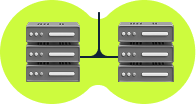It is imperative for any business to attract a steady flow of potential customers. Without ongoing opportunities to pitch a product or service, sustaining revenue and growth becomes rather challenging.
While inbound methods like content marketing and SEO often receive center stage, outbound lead generation can also be a significant element of the strategy. When you personally connect with potential customers, you initiate authentic and meaningful conversations.
In today’s competitive business environment, combining inbound and outbound strategies provides a solid chance at increasing the customer base. With the right plan and tools, outbound outreach can be natural, supportive, and perfectly timed.
What are outbound leads and their types?
First and foremost, let’s define outbound leads. They are potential customers that you identify and contact when you see the slightest signs of interest. However, you need to contact them first; don’t wait for them to ask for inquiries. Reach out to them through emails, calls, social messages, or direct mail.
Outbound leads don’t explicitly ask about the product; they become aware of it after you introduce it to them. These leads might be new prospects, previously unengaged contacts, or decision-makers in your target market.
There are two categories of outbound leads:
- Marketing Qualified Leads (MQL): Potential customers who have expressed interest in your product or service through marketing activities (e.g., downloading a resource or signing up for a newsletter) but aren’t yet ready for direct sales engagement.
- Sales Qualified Leads (SQL): Possible clients who have been evaluated (e.g., through outreach or based on specific requirements or desires) and considered ready for direct sales follow-up because they show a clear intent to purchase.
What is outbound lead generation?
Outbound lead generation is a marketing approach focused on actively finding and identifying potential customers who may not yet know about a product or service but who you can directly contact and spark their interest. That way, you can start building a sales pipeline.
How does outbound lead generation work?
Building an outbound lead generation strategy requires several important steps. First, you research the market to find people who would benefit from your products or services. Then, you gather prospects using tools, databases, or partnerships.
The next step is direct outreach, using calls, emails, or social media. Over time, you keep in touch, gauge the extent of their interest, and guide those who respond positively toward a conversation about working together.
In Layman’s terms, the foundation of the entire process should be the following:
- Market research: Get to know your ideal customer.
- Prospect sourcing: Find relevant decision-makers.
- Initial outreach: Contact them and establish the first connection.
- Nurturing & following-up: Keep in touch and share helpful info.
- Conversion: Guide interested leads into the next steps of the sales process.
Outbound marketing process
The outbound marketing process emphasizes broad awareness and engagement. Marketers identify target audiences, craft messages that resonate with them, and choose the right channels, such as targeted LinkedIn ads or industry newsletters.
The core element of the strategy is launching campaigns, measuring responses, and adjusting the approach based on the collected data. The goal is to create interest, build familiarity, and prompt prospects to engage with the outbound sales team later.
Outbound sales process
The outbound sales process is more direct. Typically, sales reps identify specific prospects, reach out with personalized calls or emails, and quickly attract their interest.
If a lead seems promising, sales reps set up a meeting or demo. The sales team helps the lead decide to purchase by answering questions, giving further information, and addressing objections. If the lead isn’t a good match or shows no interest, the sales reps move on.
Outbound vs. inbound lead generation: key differences
Although both inbound and outbound strategies provide leads, their general approaches and methods are different.
The Outbound strategy is all about making the first move. It is, however, up to you who to contact and when. The strategy suggests immediate engagement, which can be crucial if you need quicker wins or want to reach specific accounts.
The Inbound strategy builds trust over time and can produce highly interested leads. Generally, you wait for prospects to come to you, as they are often attracted by informative content or organic search results. However, this approach requires patience.
| Outbound | Inbound |
|---|---|
| Proactive outreach: You decide who to contact. | Attraction through content: Leads find you via blogs, videos, or social media. |
| Targeted selection: You choose leads that fit precise criteria. | Longer nurturing cycles: Leads discover the brand at their own pace. |
| Direct interaction: Quick engagement through calls or emails. | Higher qualification probability: Inbound leads often show more intent by engaging with your content. |
Combining inbound and outbound methods
A fair share, 91% of marketers to be exact, consider lead generation their top goal, highlighting its significant role in business growth. Mixing inbound and outbound lead generation strategies works best for many businesses. Use inbound to build authority and outbound to accelerate opportunities. Together, they create a balanced lead generation engine.
Benefits of outbound lead generation
Outbound efforts are particularly beneficial for companies looking to expand quickly or enter cutthroat markets, as this strategy provides a proactive means of locating and establishing a connection with prospective clients. Let’s have a look at the key benefits:
- Faster market penetration: By focusing on specific industries or geographical areas, outbound strategies allow companies to penetrate new markets quickly. This proactive strategy raises awareness more quickly and creates opportunities that passive marketing may not be able to provide.
- Predictable results: Unlike inbound strategies that depend on audience behavior, outbound efforts reliably produce leads. With metrics like response and conversion rates, businesses can forecast outcomes and maintain control over lead acquisition goals.
- Invaluable market feedback: Direct communication with prospects often uncovers insights into market trends, buyer objections, and competitor positioning. This real-time feedback can change the perspective on offers and produce broader marketing strategies.
- Reactivation of dormant leads: Outbound efforts can re-engage previously cold leads. Businesses can reignite interest and potentially close missed opportunities by targeting these prospects with updated messaging or offerings.
- Stronger brand awareness: Outbound lead generation can increase brand recognition through repeated exposure. Even if prospects don’t convert immediately, consistent engagement can keep your brand on top, laying the groundwork for future opportunities.
How to build an effective outbound lead generation strategy?
Regardless of the industry, effective outbound lead generation strategies are a cornerstone for expanding the customer base. By combining a structured approach with consistent execution, you can reach the target audience and convert prospects into loyal customers. Here are five essential steps for doing so.
1. Define your Ideal Customer Profile (ICP).
Start by identifying the main elements of the target audience, such as demographics, behaviors, and pain points. A well-defined ICP ensures that you contact prospects who are most likely to engage with the product offering. Use data from existing customers to shape this profile.
2. Build and segment a prospect list
To put together a list of possible leads, use reliable data sources like CRM tools, industry directories, and LinkedIn. Sort the list according to criteria like industry, location, or company size. Segmenting your collected data will help you create personalized messages that resonate with each prospect’s needs.
3. Develop a strong outreach message
Create clear and concise messages that address your possible clients’ challenges and explain how the solution you offer can solve them. Avoid generic pitches and focus on communication that brings value. Test different versions to see which resonates best, and adjust the message accordingly.
4. Choose the right outreach channels
Select channels where the target audience is most active—email, cold calling, social media, or direct mail. While a multi-channel strategy might increase reach and engagement, you also need to make sure that the messages you want to convey are consistent across all platforms.
5. Track performance and refine the approach
Keep an eye on important data, such as response rates, appointment bookings, and conversions. Determine what works and what doesn’t. Adjust the strategy regularly to optimize results and maintain the lead generation efforts.
By following these steps, you can connect with the right prospects, effectively communicate your value, and constantly grow the business.
Best outbound lead generation techniques
To drive growth, businesses need to master specific techniques in order to attract, engage, and convert potential customers. The key is selecting tactics that fit your market and resources.
Below are the main approaches that can help you develop a specific marketing strategy that’s unique to you. Each focuses on different channels or methods. Mixing a little bit of everything can help you cover multiple angles.
Cold Calling
Cold calling involves directly contacting potential customers to introduce your product or service and attract their interest. A structured and well-written script combined with great delivery can increase the chances of grabbing their attention.
Best for:
- Telecommunications: Introducing new services to consumers and businesses.
- Real Estate: Reaching out to potential buyers or sellers about property opportunities.
- Insurance: Contacting prospects about policies and coverage options.
- Financial Services: Calling businesses or individuals about financial products and services.
How MightyCall can help?
MightyCall’s cloud-based call center software allows your team to manage calls from anywhere, offering flexibility.
- Auto dialer is a call automation tool for outbound campaigns. It saves time and lets agents focus on engaging leads instead of manual dialing.
- Call routing is more suitable for inbound campaigns. It directs leads to the right agents, improving response times.
- Detailed analytics and reporting track performance, allowing you to optimize strategies as you go.
schedule your personalized demo with our amazing team

Cold Emailing
Sending personalized emails to prospects is a popular lead-generation tactic for sharing value, introducing your business, and starting a conversation. Focusing on relevance and clear calls to action increases engagement during a cold emailing campaign.
Key elements of good email outreach:
- Personalized subject lines
- Concise messaging
- Clear call to action
Best for:
- Software/SaaS: Reaching out to prospects about product features and trials.
- Consulting: Contacting businesses that could benefit from expertise or services.
- Marketing Agencies: Offering services to businesses looking to improve marketing efforts.
- Education: Sending targeted messages about courses or certifications to potential students.
Social Media Outreach
Connect with prospects on LinkedIn, Twitter, or Facebook to build relationships and generate leads. Personalized messages and engagement with their content can build trust and develop social selling.
Best for:
- B2B Services: Engaging with decision-makers and professionals via LinkedIn and other platforms.
- Technology: Reaching out to companies or users interested in new tech products.
- Consumer Goods: Creating engagement with consumers through social platforms to generate leads.
- Healthcare: Connecting with medical professionals and patients through social media platforms.
Pay-Per-Click (PPC) Retargeting
Using paid advertising platforms to reach previously identified prospects. Ads tailored to specific audiences can bring them back to consider your offering.
Best for:
- E-commerce: Re-engaging visitors who abandoned their carts or didn’t complete a purchase.
- Education: Targeting individuals who previously interacted with online courses or degree programs.
- Technology: Retargeting visitors who have shown interest in tech products or solutions.
- Healthcare: Following up with patients or clients who visited medical service pages but didn’t convert.
Telemarketing Follow-Ups
Follow up with prospects who’ve previously engaged with your content or campaigns via calls to keep them moving through the sales funnel.
Best for:
- Retail: Following up with customers who showed interest in a product but did not purchase it.
- Software/SaaS: Reaching out to leads who have interacted with a product demo or free trial.
- Education: Following up with potential students who seem interested in a program.
- Healthcare: Following up on leads who have shown interest in scheduling appointments or consultations.
How MightyCall can help?
MightyCall can be a valuable tool for telemarketing follow-ups in outbound lead generation by offering several key features that make communication simpler and more efficient. Here’s how the MightyCall solution can help:
- CRM integration allows you to access lead information directly during calls.
- Call recording and Playback help train your team, identify areas for improvement, and ensure that all compliance requirements are met.
- Internal call notes and comments will help you track important information, which you can share with team members to ensure cohesive communication with clients.
By combining these features, MightyCall ensures that outbound sales processes are efficient, well-organized, and personalized, increasing the chances of success of your telemarketing efforts.
schedule your personalized demo with our amazing team

Content Syndication
Content syndication involves distributing your content (e.g., articles, case studies, infographics, and reports) to third-party platforms or websites to reach a broader audience. It helps increase visibility, drive traffic, and generate leads by placing your content in front of users who may not have encountered your brand otherwise.
Best for:
- SaaS providers: Syndicating software feature updates or industry reports on tech blogs.
- Insurance companies: Distributing white papers on risk management or coverage options to industry-specific sites.
- Health tech companies: Distributing content about new medical technologies or health innovations on healthcare news websites.
- Online course providers: Syndicating content about learning opportunities and career tips to educational platforms or blogs.
Industry events and webinars
Events, whether virtual or in-person, bring together people with common interests. Hosting a webinar on problem-solving techniques for call centers attracts an audience relevant to your niche.
After the event, contact attendees, referencing the event’s content and thanking them for participating. This is a great ice-breaker that creates a natural starting point for conversations.
Best for:
- Finance/Banking: Attending financial events to meet potential investors or clients.
- Technology: Connecting with potential partners or customers at tech conferences or trade shows.
- Marketing and Advertising: Building relationships with clients and collaborators at industry events.
- Manufacturing: Meeting potential business clients and partners at industry-specific trade shows.
Referral programs and strategic partnerships
Partnering with complementary businesses lets you share leads. Each partner benefits by referring clients who might also need your solution.
For example, a call center software provider can collaborate with a training consultancy. As the consultancy signs a new client, it can recommend your solution, giving you a warm outbound lead.
Best for:
- Consumer Goods: Encouraging customers to refer friends or family for discounts or rewards.
- B2B Services: Building a network of leads through client recommendations.
- Real Estate: Leveraging current clients to refer friends and family for real estate opportunities.
- Healthcare: Getting referrals from existing patients or professionals within the medical field.
Consistency, personalization, and a deep understanding of your target audience are critical to the success of these outbound sales lead-generation techniques.
Preventing mistakes in your outbound lead generation process
Even strong strategies fail if executed poorly. Certain pitfalls can derail your efforts. Awareness helps you avoid wasting time or damaging your reputation.
1. Not defining your target audience
Without clear personas, you’ll waste resources contacting the wrong people. Know who benefits most from your solution.
Tips for proper audience definition:
- Research markets
- Use existing customer data
- Refine over time
2. Using generic, impersonal messaging
Mass outreach often falls flat. Prospects can tell when they’re reading a template. Personalize messages by referencing their industry or company name.
How to personalize:
- Research prospects
- Mention relevant challenges
- Keep it simple
3. Being too aggressive or pushy
Multiple follow-ups with no added value irritate prospects. Persistence is good, but respect boundaries. Offer something helpful each time.
Balancing persistence and respect:
- Set a follow-up schedule
- Provide helpful info
- Know when to stop
4. Ignoring data and not measuring results
Without tracking metrics, you can’t improve your outbound lead generation strategy. Monitor open rates, call conversion, and responses. Use software and CRM tools to gather data and refine your approach.
Metrics to monitor:
- Response rate
- Conversion rate
- Closing ratio
5. Neglecting follow-up and lead nurturing
One outreach attempt rarely seals the deal. Follow-ups matter. To keep prospects engaged, offer educational content or highlight success stories.
Effective follow-up methods:
- Scheduled reminders
- Varied content
- Track engagement
Stay ahead in a competitive landscape
The sales and marketing fields evolve daily. Outdated methods lead to wasted time and missed opportunities. Upgrading your outbound approach means adopting and adjusting to the ever-changing digital world.
Modern technology, richer data, and improved outreach techniques can increase lead quality and improve results. However, staying relevant requires a lot of work, as competitors constantly improve their strategies.























